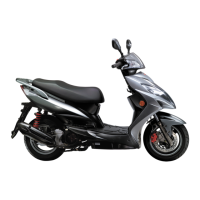
Do you have a question about the KYMCO Movie 125 2V and is the answer not in the manual?
| Displacement | 124.6 cc |
|---|---|
| Compression Ratio | 9.2:1 |
| Fuel System | Carburetor |
| Ignition | CDI |
| Front Suspension | Telescopic fork |
| Front Tire | 110/70-12 |
| Rear Tire | 120/70-12 |
| Seat Height | 780 mm |
| Fuel Capacity | 6.5 liters |
| Starting System | Electric and kick start |
| Transmission | Automatic |
| Front Brake | Disc |
| Rear Brake | Drum |
| Length x Width x Height | 1, 880 x 700 x 1, 130 mm |
| Wheelbase | 1, 300 mm |
| Engine Type | Single-cylinder, 4-stroke, air-cooled |
| Bore x Stroke | 52.4 mm x 57.8 mm |
Advice on appropriate attire for safe motorcycle riding, including helmet, clothing arrangement, and footwear.
Guidance on proper sitting posture, leaning for turns, and riding on damaged roads for motorcycle safety.
Information on maintaining good posture and understanding load capacity limits for safe motorcycle operation.
Instructions for operating the ignition switch, locking the steering handlebar, and the methods for locking and unlocking.
Procedure for starting the engine using the electric starter button, including safety precautions.
Explanation of the headlight switch positions and their corresponding light functions (off, position lights, headlights).
Details on using the headlight dimmer switch for high and low beams and the associated indicator light.
Instructions for operating the horn button and turn signal switch, including their function and limitations.
How to unlock and lock the seat, store a helmet in the met-in box, and safety warnings.
Steps for securing a helmet using the helmet buckle and cautionary advice regarding helmet storage.
Explanation of the motorcycle's instruments including mileage, speedometer, indicator lights, and fuel gauge.
Importance of performing pre-ride inspections for safety and vehicle maintenance, especially after 300km.
Procedure for checking and refilling engine oil, including safety precautions regarding hot parts.
How to inspect brake performance, including checking brake lever free play within the specified range.
Guidance on checking tire pressure, cracks, wear, and tread depth for safe operation.
Procedure for checking and refilling the fuel level, including safety precautions for refilling.
How to inspect the steering handlebar for damage, loose parts, and free rotation.
Checking the proper operation of speedometer, fuel gauge, turn signal, and high beam indicator lights.
Adjusting and checking the free play of the brake levers to ensure proper braking.
How to inspect brake shoes for wear and when to replace them, with service limit information.
Procedures for inspecting the horn, headlight, taillight, stoplight, and turn signal lights.
Checking front/rear shock absorbers, overall brake performance, and ensuring proper braking effect.
Inspecting rear mirrors, license plate, reflectors, previous repairs, and lubrication points.
Steps to turn the ignition switch to the correct position for starting the engine, with safety precautions.
Procedure for using the electric starter button, including throttle control and battery saving advice.
Instructions for starting the engine using the kick lever, including cold start procedures and safety warnings.
General guidance on starting the engine and related safety precautions before moving.
Procedure for safely removing the motorcycle from the main stand before riding.
Advice on maintaining a correct and safe riding posture, including foot placement and attire.
How to smoothly rotate the throttle grip to start moving, with warnings about sudden acceleration.
Guidelines for safe riding, including using turn signals, lane positioning, and moderate riding for engine life.
How to control speed using the throttle grip (rotate to accelerate, restore to decelerate) and braking.
Tips for prolonging engine life, including speed limits for new motorcycles and avoiding rapid acceleration.
Best practice for braking by using both front and rear brakes simultaneously and smoothly.
Warning against sudden stops and sharp turns, especially in slippery conditions, to prevent accidents.
Precautions for riding in rain, including increased braking distance and slowing down on descents.
Procedure for signaling, slowing down, and stopping the motorcycle safely near a parking area.
Steps to take after the motorcycle has stopped, including turning off the ignition switch.
Instructions on how to park the motorcycle safely on its main stand and avoid hindering traffic.
Procedure for locking the steering handlebar after parking to prevent theft and safety warnings.
How to inspect, clean, or replace the air cleaner element and its maintenance intervals.
Checking rubber covers on connectors for proper installation and cleaning methods.
Tips for cleaning the motorcycle's appearance to prevent dust affecting components and waxing precautions.
Information on the battery, including cleaning terminals, checking for corrosion, and safety precautions during removal/installation.
Procedure for changing a blown fuse, checking the fuse clip, and using correct fuse capacity.
Step-by-step guide for changing engine oil, including specified oil type, capacity, and maintenance intervals.
How to check and refill transmission gear oil, recommended oil type, capacity, and change intervals.
Procedure for inspecting, cleaning, and replacing the spark plug, including gap specification and maintenance intervals.
How to inspect and refill brake fluid, including recommended fluid type and safety warnings.
How to measure and adjust the throttle grip free play to the specified range.
Troubleshooting steps for engine starting issues or stops during riding, checking fuel and correct procedure.
Advice on what to do in case of a breakdown, recommending contacting a KYMCO distributor or service station.
Schedule for periodic inspection and maintenance to ensure safe riding and prolong service life.
Technical specifications for the KYMCO Movie 125 2V and 4V models, including engine, dimensions, and capacities.